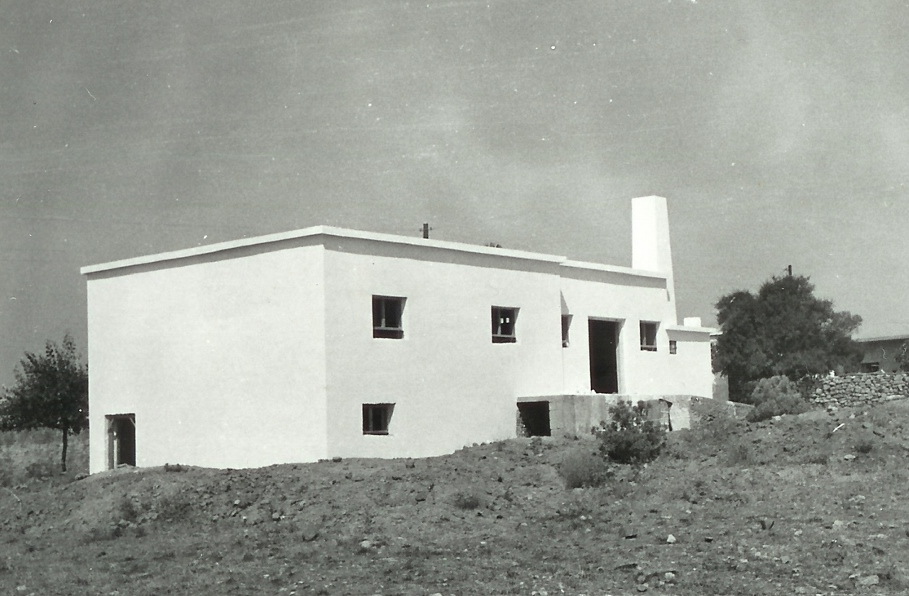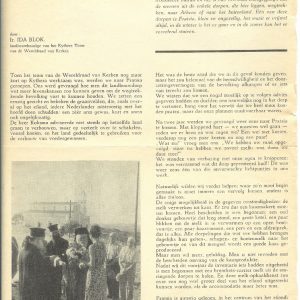WCC Team Kythera and the cheese factory of Fratsia.
And why Fratsia got its water supply system one year later.
January 1967 George Koksma wrote:
“Fratsia is the promising village of today. The cheese cooperation will start 1st of March. But I am full of sorrow because of a possible failure. There are only 25 members and just now 3 of them lost a cow, worth 10.000 drachms, US $ 300, because they had no insurance which would have cost 250 drachms. Meanwhile they asked advice concerning the import of Dutch cattle. Although I knew the very fine results of such walking grass eating super milk factories, I declared myself against it. We are at Kythera and will follow the considered judgment of the Greek central governmental experts: Brown Swiss it has to be!”
How did this idea for the cooperation start? Bishop Meletios had requested the organization of a Greenery at Fratsia and with a lot of governmental officials and foreign visitors a visit was paid on 31 May 1962 to this exhibition of all kinds of home and agricultural products and livestock. From the beginning of 1960 the Team had promoted to grow animal food and to raise and improve the livestock. Fratsia proved to have done very well and representatives of the village now asked George what to do with the milk of the 60 cows they had now. George only could promise to study the possibility for a small cheese factory.

In the Team’s activity overview of the year 1965 George mentioned that a private cheese factory had started but that farmers of Fratsia would like to make a cooperative out of it. But how do they think to achieve this, the village has no drink water supply system, how to collect the milk and who knows how to manage this business?
In February 1967 in Holland they had started the organization for 2 summer work camps to bring water to the villages of Mylopotamos and Fratsia. At Kythera the Team’s two technical students, the last two that were to come to Kythera to assist the team on technical matters, had started a survey to make a map of Fratsia for the drink water project. However the Prefect of Piraeus meanwhile expected very soon a final approval on the overall island water supply system and which then was going to be executed by the government. Now the Bishop is of the opinion that it does not seem right for Holland to spend money and energy for more local water supply plans at Kythera. The Government will take over and the Dutch donators can better help us with a modest cheese factory. Our idea now will be a cooperative of all Kythera! The Team then makes in June a design for a new building to house the cheese factory.

At that time the cheese factory is housed in an old barn in Fratsia, there are 30 milk productive cows and the cooperative is formed by 25 local members. George for this reason has to inform the Dutch town ‘s Hertogenbosch that the fund raising campaign for their “water to the village” project please should be renamed into “give Fratsia a cheese factory”. The Team has agreed to the wish of the Prefecture to continue the Team’s topographical surveys of several other villages. The government then will make use of these plans to carry out the actual installation of the pipes and to make the house connections.
In July people of Fratsia organized the lodgings for the young Dutch volunteer workers from the town ‘s Hertogenbosch who were going to stay and work for three weeks. Already in Holland, with aid of the “Kythera Vriendenkring Nederland” (Dutch Society of Friends for Kythera), they had collected money to start the construction of the cheese factory. A cool room is required when manufacturing cheese that is why the work campers started digging a deep cellar in the rocky soil. In 3 weeks time they finished the excavation and poured the reinforced concrete cellar floor. The Bishop blessed the start of the work.
As planned by local people and the Team the factory was intended to process 400 gallons of milk maximum per day. The milk from goats and cows was to come from Fratsia and the surrounding villages and the idea was that in future they would produce enough cheese for the whole island. After the campers had left local people from Fratsia voluntarily continued with laying the brick walls for the cellar. In September on request of the Team a master brick layer did join them to do the more skill requiring difficult masonry parts.


Promised money from WCC Holland to continue the building arrived very late in October 1967. From ‘s Hertogenbosch a donation of 40.000 drachms and from the town Ede, the centre of the CPJ (), even 200.000 drachms. The Team now has the money to go on and find a local contractor to construct and pour the concrete ground floor over the cellar. But by now it is olive picking time and labourers are very difficult to be found. After the harvest time again people from Fratsia continued the work, but slowly as it rained too often. By the end of February 1968 the ground floor was finished and the bricklaying completed to underside of roof. Window and door frames are being installed and roof is poured in April. The electricity system is connected and the plastering of interior walls is finished in May.
Mid July 1968 another work camp from WCC Holland handles a finishing touch around the building. This same summer camp, by request of the Governor in June, also started the work on the community water supply system that was supposed to have started last year. The new building for the cheese factory now is ready, but it is empty and has not yet the required equipment to make cheese. By the end of the year a telegram from WCC Geneva arrived. A Norwegian church had sent money which could be used to order the necessary inventory!

In the Team’s monthly work reports in 1969 very little is mentioned about cheese making. George already for more than one year has to do everything himself for there are no more other Team members to help him on the still many various technical projects. Fortunately in 1968 former technical student members of his Team had come to help in their vacation time with the summer camps. George contacts the KVN, the Dutch Society of Friends for Kythera, and asked them to please raise funds to send a young boy from Fratsia, Panayotis Petrochilos, to Ioannina early 1970 to learn and become a professional cheese maker. With a donation of a Canadian Self Help Project the last required work in the new building was completed. This was a last mention in the Team’s monthly work reports about the cheese factory. In KVN’s Dutch periodicals ‘IRIS’ from April 1969 – September 1971 however additional information could be found.

Young Panayotis has to go to school in Ioannina 6 months per year for a period of two years, starting in January 1970. The government will pay his tuition, but not his travel and accommodation expenses. George estimates that including pocket money this will be 10.000 drachms per annum. In the town Vlaardingen in Holland the KVN holds as of 1966 a yearly walking tour to collect money for the Team’s projects on Kythera. They decide that the total profit of the 5th walking tour of September 1970 will be allocated for the personal expenses for the training of the new cheese maker. A remarkable 1350 (!) hikers of various ages and thus walking from 5 to 25 km do yield a sum of 18.500 drachms; enough to cover the personal expenses for the 2 years required training of young Panayotis.
In 4 Dutch provinces another fund raising project “Yes Fratsia” is started mid 1969 by different divisions of the CPJ, the Dutch Christian Rural Youth Society. They aim for 160.000 drachms. This money, a starting capital, is needed for a manager, a milk truck and some road improvements necessary for the truck to reach remote living farmers. Early 1970 already 80.000 drachms had been collected and the campaign closed at a total of 120.000 drachms. Panayotis Petrochilos in August 1971 returned to Kythera as a trained cheese maker.
The Team’s activities were stopped in September 1971. How well the factory worked and for how many years is known only to the people of Fratsia.
A pity George’s words “I am full of sorrow because of a possible failure” came true.
Jean Bingen
(click on photo to enlarge)












